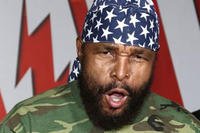America's 39th president held a lot of jobs in his time. Apart from being president of the United States (and sometimes while serving as president), Jimmy Carter was a peanut farmer, preacher, professor and even a parole officer. But he started his adult life as a U.S. Navy officer, most famously working with Adm. Hyman Rickover, the "Father of the Nuclear Navy."
The longest-lived American president died on Sunday, December 29, 2024, at his home in the small town of Plains, Georgia, where he and his wife, Rosalynn, who died at 96 in November 2023, spent most of their lives.
Though he started his naval career aboard diesel electric submarines, Lt. Carter began working with the Naval Reactors Branch of the U.S. Atomic Energy Commission -- the Navy's nuclear submarine program -- in 1952.

Rickover was infamous in the Navy for demanding near-absolute perfection from those working under his command. His expectations of the then-28-year-old Carter were no different. The young lieutenant was being groomed as the engineering officer for the nuclear plant aboard the USS Seawolf, the Navy's second nuclear sub, and was designing the training program for its nuclear enlisted personnel.
The Navy's work in developing the first nuclear submarine, the USS Nautilus, meant that Rickover and Carter had access to the latest and greatest in top-secret nuclear energy technology. So when Canada's Chalk River nuclear research facility experienced a power surge that damaged its reactor, the U.S. sent Carter and his team. He was one of a few people in the world who could do it.
Fuel rods at the research reactor experienced a partial meltdown after the power surge. It ruptured the reactor and flooded the facility's basement with radioactive water, rendering the reactor core unusable.
In his 2015 autobiography, "A Full Life: Reflections At Ninety," Carter described the incident and his preparations for repairing the reactor. They built an exact replica of the reactor, true to the last detail (except the actual nuclear material) on a nearby tennis court to practice and track their progress.
Carter and his 22 other team members were separated into teams of three and lowered into the reactor for 90-second intervals to clean the site. It was estimated that a minute-and-a-half was the maximum time humans could be exposed to the levels of radiation present in the area.
It was still too much, especially by today's standards. The future president had radioactive urine for months after the cleanup.

"We were fairly well-instructed then on what nuclear power was, but for about six months after that, I had radioactivity in my urine," Carter told CNN in 2008. "They let us get probably a thousand times more radiation than they would now. It was in the early stages, and they didn't know."
The exposure was especially dangerous for Carter, whose family medical history is full of cancer deaths. His father died of pancreatic cancer in 1953, which led to Carter leaving the Navy that year. Cancerous tumors were found on the former president's liver and brain in 2015 as he turned 91, but quick diagnosis and treatment led to a cancer-free bill of health a year later.
His extensive knowledge of nuclear reactors and energy would come in handy when Carter became president in 1977, as other world leaders respected his knowledge on the subject.
-- Blake Stilwell can be reached at blake.stilwell@military.com. He can also be found on Twitter @blakestilwell or on Facebook.
Want to Learn More About Military Life?
Whether you're thinking of joining the military, looking for post-military careers or keeping up with military life and benefits, Military.com has you covered. Subscribe to Military.com to have military news, updates and resources delivered directly to your inbox.
















